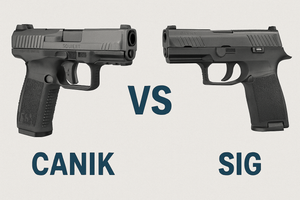Which one’s better—Canik or Sig Sauer? If it were just about personal taste, maybe it’d be a Coke vs. Pepsi kind of debate. But when it comes to handguns, the stakes (and specs) are a lot higher.
To make a real comparison, you’ve got to match the right models—apples to apples. Which Canik stacks up against which Sig?
Both brands have earned serious respect in the gun community. Both started outside the U.S. and built their way into trusted names for military, law enforcement, competitive shooters, and everyday carriers alike.
Are Canik and Sig Sauer the same? Not quite.
In this guide, we’re breaking down the matchups that matter: Canik TP9 vs. Sig Sauer P320. We’ll look at options for competition, concealed carry, tactical use- model by model.
Stick around—this one’s going to be a solid head-to-head.
About Canik Firearms
Canik is a widely recognized firearms manufacturer focused on innovation, quality, and affordability. The company was founded in 1998 in Turkey, originally manufacturing aerospace components for industry giants like Boeing and Airbus.
In 2005, Canik shifted gears and entered the firearms market, setting up state-of-the-art production facilities in Samsun. Their first pistol, the Canik 55, was built for military and law enforcement use—tough, reliable, and duty-ready.
But the game really changed in 2012 when Canik partnered with Century Arms, the largest U.S. firearms importer. Their goal was to compete with big names like Glock and Sig Sauer. To do so, they introduced the TP9 series, striker-fired 9mm pistols combined military-grade reliability with modern features and a price point that shook the market.
Fast-forward to today, and Canik is producing over 450,000 pistols a year. The brand has earned serious traction in the U.S., especially among competitive shooters and everyday carriers looking for quality without the premium price.
And in a major move, the company recently announced that it’s bringing production to the US—American-made Canik pistols are coming in 2025.
About Sig Sauer
Sig Sauer is one of the most respected firearm manufacturers in the world. Known for blending German engineering, Swiss precision, and American innovation, Sig has built a legacy of performance, trust, and military-grade reliability.
The company’s roots go back to 1970, when Germany’s J.P. Sauer & Sohn partnered with Switzerland’s SIG—originally a wagon manufacturer for the Swiss Army. That collaboration gave birth to the Sig Sauer brand as we know it today.
By the 1980s, Sig made its way to the U.S. under the name SIGArms, and in 2007, they doubled down on American production by launching Sig Sauer Inc. to meet growing domestic demand.
Fast-forward to today, and Sig Sauer is a powerhouse. They produce over a million firearms annually, with their P320 series leading the charge. This modular, striker-fired polymer pistol became famous for winning the U.S. military contract and now serves as the official M17 and M18 sidearms.
Key Comparisons
What makes both Canik and Sig Sauer handguns so great? Simple—they both deliver serious performance and quality, but they get there in different ways.
Performance & Trigger Feel
You’ve probably heard this before: Canik pistols offer incredible out-of-the-box value. You’re getting a clean, crisp trigger, tight accuracy, and smooth recoil control—right out of the case.
Many shooters say Canik triggers feel lighter and snappier than most factory options, with a short reset that makes fast follow-up shots a breeze.
On the Sig side, you get elite-level performance and modular design, especially in models like the P320 Legion, where the trigger is refined, clean, and tuned for competition.
Reliability & Track Record
This one’s close. Canik handguns, like the TP9 Elite Combat, are NATO-approved and built to military-grade specs. They’re duty-ready and trusted around the world.
Sig Sauer brings its own heavy credentials to the table—the P320 series (including the M17 and M18) was adopted by the U.S. military. That says a lot about Sig Sauer reliability and its real-world performance.
That said, it’s worth noting that pre-2017 P320 models had drop safety concerns. Sig responded with a voluntary upgrade program, and modern versions have resolved the issue.
Ergonomics & Feel
Canik pistols are known for their excellent ergonomics and sleek design. Most come with interchangeable backstraps, refined slide cuts, and a balanced grip angle that feels natural in hand.
Sig pistols, especially the X-Series, feel a bit more robust and locked-in. The grip texture, weight, and contouring offer a more refined sense of control, especially appreciated by seasoned shooters.
Features & Modularity
Here we are dealing with two completely different approaches: Canik’s TP9 models are loaded with features, while Sig Sauer’s P320 is all about customization.
Canik features include optics-ready slides, match-grade barrels, flat-faced triggers, and accessories like holsters or spare mags—all included out of the box.
Sig Sauer, on the other hand, set the standard for modular pistols. The Fire Control Unit (FCU) lets you change slides, grips, and even calibers—creating a pistol tailored to your exact needs.
Build Quality & Materials
Both brands are strong here. Polymer pistols have taken over the handgun world, and both Canik and Sig do them right. Their striker-fired models are rugged, tested, and built with high-grade materials that hold up to serious use.
Price & Value
Here is one of the biggest differences between Canik and Sig Sauer: price.
Sig Sauer pistols are generally more expensive, especially once you start customizing or adding extras. Canik pistols offer more value right out of the box, with many models outperforming pricier competitors in stock form.
That’s why you see so many head-to-head comparisons in the Canik vs Sig conversation. They're both solid—but they cater to different priorities. Let’s see how.
Concealed Carry: Canik TP9SF Elite vs P320 Compact

Let’s start our side-by-side comparisons with some great concealed carry options. The Canik TP9SF Elite and the Sig Sauer P320 Compact are worthy contenders here. Each one offers 15+1 capacity, striker-fired reliability, and a carry-friendly footprint.
Still, we need to clarify that both lean slightly bulkier than your average subcompact. The TP9SF Elite is a bit thicker, measuring about 1.45 inches at the controls, while the P320 Compact tends to be slightly slimmer, depending on the grip module. The Sig usually ships with a medium-sized grip, 1.4 inches.
In terms of recoil and control, Canik may have the edge thanks to its lower bore axis and slightly longer slide. That translates to a flatter shooting experience, especially when paired with a 45 Blast Yedi compensator.
The P320 Compact handles recoil well, but the trigger feels heavier compared to the Canik's clean, crisp break and short reset.
Sights are another key difference. The TP9SF Elite comes with Warren Tactical fiber-optic sights—great in bright light, but not ideal at night. The P320 Compact usually ships with SIGLITE tritium night sights or steel contrast sights, giving it better low-light utility.
Competition: Canik TP9SFX vs P320 XFive Legion
Next, let’s talk about competition-ready pistols. Both the Canik TP9SFX and the Sig Sauer P320 XFive Legion are both built to win. These full-size, striker-fired pistols are built for speed, accuracy, and consistency—and they’ve both passed 10,000-round tests without failures.
The TP9SFX comes with a 5.2" match-grade barrel, optic-ready slide, and a flat-faced trigger that breaks light and clean. It has a long slide and low bore axis, which help it track flat and stay on target. Add a 45 Blast TP9 SFX compensator, and it becomes even more controllable under rapid fire.
The P320 XFive Legion is built to compete with a heavier, premium feel. Its 5.0" bull barrel and tungsten-infused frame give it added weight and balance, helping reduce recoil naturally. The trigger is one of the best Sig has ever put in a gun—smooth, crisp, and made for fast, confident shooting.
Both pistols ship with 18-round mags, but the TP9SFX gives you a bonus with a 21-round magazine included. With the Legion, you'll need to buy extended mags separately.
Sight-wise, both guns are ready to compete. The TP9SFX features adjustable rear and fiber-optic front sights, while the Legion upgrades to Dawson Precision sights, which are fully adjustable and top-tier for match shooting.
The main difference comes down to price. The TP9SFX offers top-end performance at a budget-friendly cost. The XFive Legion delivers a premium feel for also a premium price.
Tactical Shooting: Canik TP9 Elite Combat and the Sig P320-M17
For our third Canik vs Sig Sauer comparison, we go to military-grade reliability. The Canik TP9 Elite Combat and the Sig P320-M17 are both tested to the highest NATO standards, built for real-world duty, and designed to perform under pressure.
For people who want extra magazine capacity, here is an important note: The M17 comes with both 18- and 21-round magazines, while the TP9 Elite Combat ships with 15- and 18-rounders.
Now, let’s talk about features. Both pistols feature a 4.7" barrel, ideal for tactical roles while still offering solid control and shootability.
The Canik was developed in partnership with Salient Arms, including a threaded barrel, aluminum magwell, and premium trigger.
The P320-M17, on the other hand, was chosen by the U.S. Army. That alone says a lot about its field reliability and performance. It has that classic military profile, a solid grip, and ambidextrous controls including a thumb safety.
In terms of feel and recoil, the Canik’s low bore axis, fluted match-grade barrel, and flat-faced trigger make it incredibly smooth to shoot. You can also add a 45 blast comp for an even better shooting performance.
The trigger on the TP9 is crisp, breaks cleanly at around 3.5–4 lbs, and resets fast—perfect for tactical training or competition crossover. The P320-M17 has a solid trigger too, but with a longer pull and reset, giving it a more deliberate feel.
The TP9 Elite Combat’s tactical sights, co-designed with Salient Arms, feature a fiber-optic front, which is fantastic in daylight. The only drawback? No glow in the dark. That’s where the P320-M17 literally shines with its tritium-powered three-dot night sights, giving it a slight edge in low-light environments.
Ready to Compare Canik vs Sig Sauer Yourself?
When it comes to Canik vs Sig, there’s no wrong choice—just the right fit for your style, purpose, and preferences. You’ll find plenty of honest reviews out there, no doubt.
And here’s what many experienced shooters will tell you about both brands:
Canik TP9 series deliver incredible value, crisp triggers, and race-ready features right out of the box.
Sig Sauer P320 series brings refined control, modularity, and a track record trusted by the U.S. military.
So why not try both?
Canik and Sig Sauer offer great options for concealed carry, competition, and tactical use. You don’t have to be a one-brand shooter. Carry a Sig. Compete with a Canik. Or flip it. There’s no rule—just performance.
Set up your own shootout at the range and see which platform earns your trust.
And while you’re at it, check out our Canik compensators at the 45 Blast store. If you want to get the most out of your TP9, we’ve got what you need to reduce recoil, sharpen your speed, and tighten your groups.
Shoot smart. Train hard. Enjoy the best of both worlds.


